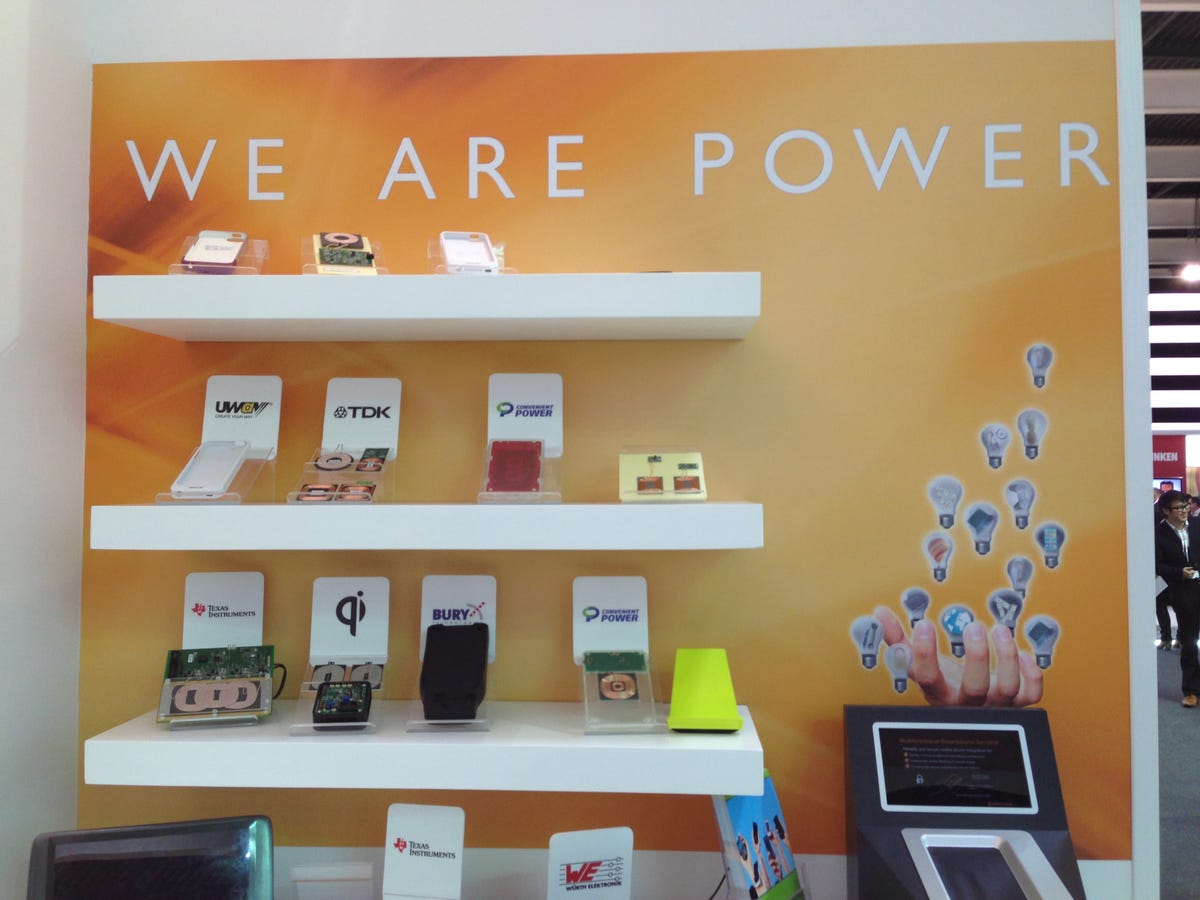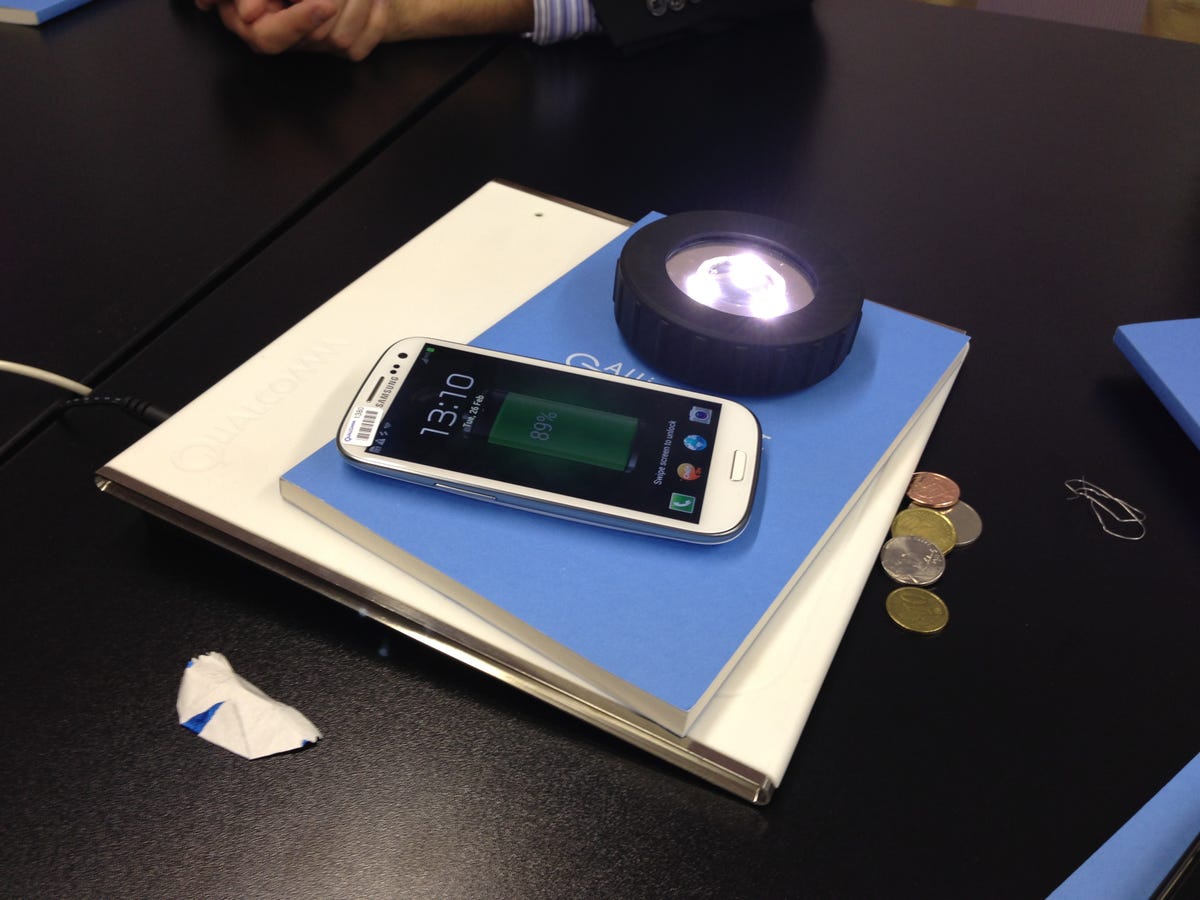As obviously useful as wireless charging is, it suffers from a Tower of Babel problem with incompatible standards and competing interests keeping it from truly going mainstream.
But the industry may yet be inching toward some level of sanity. AT&T is seeking from its handset vendors a commitment to one standard of wireless charging, CNET has learned.
Related stories
- Wireless charging blazes path toward mainstream
li> - Apple, Samsung to offer wireless phone charging, report says
- The top six wireless charging handsets
- Samsung Galaxy S4 offers optional wireless charging
The standard, known as PMA, or the Power Matters Alliance, is spearheaded by Powermat Technologies and Procter & Gamble, two unlikely leaders considering their highest-profile products are the bulky iPhone charging covers that only true power-hungry users submit themselves to using. But over the last few months, the PMA has seen a tenfold increase in membership, and its technology is used in Boston-area Starbucks, and will be used in select European McDonald’s.
Having a clear and unified standard would come as a welcome relief to consumers and a raft of companies in fields ranging from automotive to furniture looking to jump on one bandwagon or another.
“Wireless charging continues to be a niche category until there’s a common standard,” said Daniel Hays, a consultant with PricewaterhouseCoopers. “The hassle factor is still high.”
But as much momentum as the PMA has achieved, it is far from clear whether it will be that bandwagon. In fact, this year’s Mobile World Congress was all about the various alliances hawking their standard as the standard to follow.
In addition to the PMA is Qi, run by the more established Wireless Power Consortium. It’s the primary standard used in current smartphones. The Samsung Galaxy S4 , for instance, will support both standards, CNET confirmed.
Then there’s the Alliance For Wireless Power, or A4WP, which has bet on a newer, more convenient kind of wireless charging technology and counts Qualcomm and Samsung Electronics as its key backers, but isn’t expected to hit the market until next year.
I had a chance to visit each camp while at Mobile World Congress to hear their take on wireless charging, and all — unsurprisingly — were convinced their way was the right way.
‘Smart’ wireless charging
The PMA, under Duracell Powermat, had the most impressive booth presence among the three. Even at a show packed with booths big and small, Powermat Duracell was able to carve out its own presence.
Rather than the typical booth with high walls, Duracell Powermat was fairly open and brightly lit, accented by a mix of low white walls and wood accent colors. On one side sat a glass case featuring some of its Powermat iPhone cases. On the opposite end was a quasi-mockup of a Starbucks interior, complete with a wall stacked high with its coffee bags, in a demonstration of its wireless charging station.


Roger Cheng/CNET
Near the center of the booth hung a large poster with the logos of each member of the group — something that PMA executives are proud of. Daniel Schreiber, president of Powermat and a board member of the PMA, boasted that it is the fastest growing of the three groups, touting new additions including LG and ZTE.
Last week, Powerkiss, the manufacturer of wireless charging equipment that is installing stations in McDonald’s in Europe, jumped from the Qi ship and backed PMA.
It’s impressive what the group has achieved considering it’s only a little more than a year old. In fact, the PMA is the primary reason for the split, with Powermat pulling out of the WPC because it deemed it too slow-moving.
“You can get nowhere with hundreds of companies,” said Ron Rabinowitz, CEO of Duracell Powermat.
The PMA doesn’t just promise wireless charging stations, it touts its system as one that can enable stores and retailers to better stay in touch with its consumers. Power 2.0, or the next version of its standard, will add a digital layer on top of the wireless charging connection, allowing the transfer of data.
The next version of its standard will allow a store manager to monitor how long a customer has been using a charger, and even send coupons for another drink, for example.


Sarah Tew/CNET
The knock on PMA, however, has been its need for outside accessories to enable wireless charging. Powermat designed bulky phone covers for the iPhone and Galaxy S3, and showed off a new version of its cover for the iPhone 5 at the show.
Those days may be coming to an end.
“In an effort to move towards making this a reality for consumers worldwide and in direct support for the public ecosystem rollout led by Powermat, we have asked our device suppliers to provide integrated wireless charging solutions by 2014,” AT&T said in a statement sent to CNET.
AT&T has corralled nearly all of its partners, according to a person familiar with the initiative. For a company like Nokia, which has aggressively embraced the Qi standard in its flagship phones, the decision means switching technologies.
Qi, the incumbent
Walking over to the Qi booth, which is run by the Wireless Power Consortium, one can see the difference in show presence. It was less a booth and more a corner, with only two walls separating it from the numerous exhibits around it.
Its restrained presence stands in contrast to the broad adoption of Qi, which is notably found on high-profile phones such as the Nokia Lumia 920, exclusive to AT&T, and Verizon’s flagship HTC Droid DNA. Verizon has its own plan to push the Qi standard into its phones this year. Naturally, Verizon and AT&T can’t agree on much.
The Galaxy S4 will support both Qi and PMA, depending on which wireless charging back cover and appropriate charging pad is chosen, and whether it’s available at that retailer or carrier store.


Roger Cheng/CNET
In response to the PMA’s charge about infrastructure, the WPC spent its time at the show announcing different partnerships. Starting this month, Toyota Avalons can be equipped with a Qi-compatible center console as an option. Next month, it will be available for the Prius as well.
Stefan Graf, director of marketing and new technology at PLDS (Philips & Lite-On Digital Solutions), said the company has several other car equipment manufacturers lined up as well, but wouldn’t go into detail.
“We’re talking to nearly everybody,” he said.
The PMA’s big automaker win, General Motors, will support Qi as well, Graf added.
The company’s other big announcement — that Qi would end up in European McDonald’s locations — turned out to be a non-starter after the Powerkiss defect.
Tomorrow’s standard
The third group, A4WP, didn’t spring for a booth at all. In its place was a small meeting room filled with an assortment of wireless charging examples, ranging from the standard charging pad to a mock automotive center console and table top. Crowded in the room were more than half a dozen executives from companies such as Samsung and Qualcomm eager to brief me.
The A4WP probably didn’t feel the need yet to have a big presence at the show. The group is still working on deciding on a final brand — the executives conceded A4WP isn’t the catchiest of name — and still needs to finish testing and certification. A commercial rollout isn’t expected until next year.
Its method of wireless charging is powered by a wholly different technology called magnetic resonance that allows for more flexibility. Instead of lining up a device perfectly along a charging pad, only a small part of a device needs to touch the surface. A charging station can handle multiple devices, and can still charge even if there’s a magazine or other small obstruction between the phone and the surface.


Roger Cheng/CNET
“This is the first time the industry has a serious choice available for next-generation wireless charging technology,” said Kamil Grajski, president of the A4WP and a Qualcomm executive.
The demonstration was impressive. Critics, however, say it isn’t as power efficient as inductive charging, which is what Qi and PMA use, and that the frequency of the signal could interfere with other equipment. The PMA, however, has said it would look at resonance charging in the future, which suggests future standard wars.
Clint Chaplin, vice chairman of the A4WP and a principal engineer at Samsung, said that while his company has joined the WPC and supports Qi, it is really backing A4WP as the standard of the future.
The potential kingmakers
Ultimately, the standards war will be won by the side that can get the right mix of wireless charging capabilities in phones and stores and cars. The PMA is confident that its deal with Starbucks, if it expands beyond the trial in Boston, could be the deciding factor.


James Martin/CNET
Schreiber noted that the wireless Internet battles were decided when Starbucks decided to support Wi-Fi, and he hopes history will repeat itself.
Likewise, getting wireless charging capabilities in the car will go a long way toward determining which standard has some legs. Given how long consumers tend to keep their cars relative to a smartphone, many of the automakers have been reluctant to take a stand. But early adopters like General Motors and Toyota could pave the way for the rest of the industry, which is largely sitting on the sidelines.
Also conspicuously absent is Apple, which so far has refused to commit to wireless charging. While Apple Senior Vice President Phil Schiller questioned the need for wireless charging last year, the latest rumor has the company putting the feature into the next iPhone.
CNET contacted Apple to comment on wireless charging, and we’ll update the story when the company responds.
Despite the conflicting standards and potential for consumer confusion, wireless charging does appear to be heading in the right direction.
“I think it’s happening,” Powermat’s Schreiber said. “Once you get the momentum, it becomes a self-fulfilling prophesy.”



